The Effect of Neddylation Blockade on Slug-Dependent Cancer Cell Migration Is Regulated by p53 Mutation Status
- PMID: 33573293
- PMCID: PMC7866814
- DOI: 10.3390/cancers13030531
The Effect of Neddylation Blockade on Slug-Dependent Cancer Cell Migration Is Regulated by p53 Mutation Status
Abstract
The tumor suppressor protein p53 is frequently inactivated in human malignancies, in which it is associated with cancer aggressiveness and metastasis. Because p53 is heavily involved in epithelial-mesenchymal transition (EMT), a primary step in cell migration, p53 regulation is important for preventing cancer metastasis. p53 function can be modulated by diverse post-translational modifications including neddylation, a reversible process that conjugates NEDD8 to target proteins and inhibits the transcriptional activity of p53. However, the role of p53 in cancer migration by neddylation has not been fully elucidated. In this study, we reported that neddylation blockade induces cell migration depending on p53 status, specifically via the EMT-promoting transcription factor Slug. In cancer cell lines expressing wild type p53, neddylation blockade increased the transcriptional activity of p53 and expression of its downstream genes p21 and MDM2, eventually promoting proteasomal degradation of Slug. In the absence of p53, neddylation blockade increased cell migration by activating the PI3K/Akt/mTOR/Slug signaling axis. Because mutant p53 was transcriptionally inactivated but maintained the ability to bind to Slug, neddylation blockade did not affect the migration of cells expressing mutant p53. Our findings highlight how the p53 expression status influences neddylation-mediated cell migration in multiple cancer cell lines via Slug.
Keywords: PI3K/Akt/mTOR signaling; Slug; epithelial-mesenchymal transition (EMT); migration; neddylation; p53.
Conflict of interest statement
The authors declare no conflict of interests. The funders had no role in the design of the study; in the collection, analyses, or interpretation of data; in the writing of the manuscript; or in the decision to publish the results.
Figures
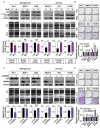
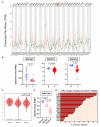
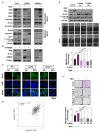
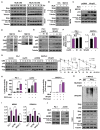


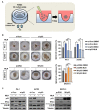

Similar articles
-
SUMOylation and NEDDylation in Primary and Metastatic Cancers to Bone.Front Cell Dev Biol. 2022 Apr 6;10:889002. doi: 10.3389/fcell.2022.889002. eCollection 2022. Front Cell Dev Biol. 2022. PMID: 35465332 Free PMC article. Review.
-
UBE1C is upregulated and promotes neddylation of p53 in lung cancer.FASEB J. 2023 Oct;37(10):e23181. doi: 10.1096/fj.202300629R. FASEB J. 2023. PMID: 37668436
-
Over-expression of lipocalin 2 promotes cell migration and invasion through activating ERK signaling to increase SLUG expression in prostate cancer.Prostate. 2015 Jun 15;75(9):957-68. doi: 10.1002/pros.22978. Epub 2015 Feb 25. Prostate. 2015. PMID: 25728945
-
Slug promotes p53 and p21 protein degradation by inducing Mdm2 expression in HCT116 colon cancer cells.Oncol Lett. 2021 Sep;22(3):681. doi: 10.3892/ol.2021.12942. Epub 2021 Jul 23. Oncol Lett. 2021. PMID: 34345306 Free PMC article.
-
Neddylation Regulates Macrophages and Implications for Cancer Therapy.Front Cell Dev Biol. 2021 Jun 7;9:681186. doi: 10.3389/fcell.2021.681186. eCollection 2021. Front Cell Dev Biol. 2021. PMID: 34164400 Free PMC article. Review.
Cited by
-
Opposing Roles of Wild-type and Mutant p53 in the Process of Epithelial to Mesenchymal Transition.Front Mol Biosci. 2022 Jun 23;9:928399. doi: 10.3389/fmolb.2022.928399. eCollection 2022. Front Mol Biosci. 2022. PMID: 35813818 Free PMC article. Review.
-
SUMOylation and NEDDylation in Primary and Metastatic Cancers to Bone.Front Cell Dev Biol. 2022 Apr 6;10:889002. doi: 10.3389/fcell.2022.889002. eCollection 2022. Front Cell Dev Biol. 2022. PMID: 35465332 Free PMC article. Review.
-
Senescence-associated secretory phenotype in lung cancer: remodeling the tumor microenvironment for metastasis and immune suppression.Front Oncol. 2025 May 29;15:1605085. doi: 10.3389/fonc.2025.1605085. eCollection 2025. Front Oncol. 2025. PMID: 40510156 Free PMC article. Review.
-
Two-polarized roles of transcription factor FOSB in lung cancer progression and prognosis: dependent on p53 status.J Exp Clin Cancer Res. 2024 Aug 21;43(1):237. doi: 10.1186/s13046-024-03161-1. J Exp Clin Cancer Res. 2024. PMID: 39164746 Free PMC article.
-
The Cellular and Developmental Roles of Cullins, Neddylation, and the COP9 Signalosome in Dictyostelium discoideum.Front Physiol. 2022 Mar 1;13:827435. doi: 10.3389/fphys.2022.827435. eCollection 2022. Front Physiol. 2022. PMID: 35586714 Free PMC article. Review.
References
-
- Weiss L. Metastasis of cancer: A conceptual history from antiquity to the 1990s. Cancer Metastasis Rev. 2000;19:214. - PubMed
-
- Powell E., Piwnica-Worms D., Piwnica-Worms H. Contribution of p53 to metastasis. Cancer Discov. 2014;4:405–414. doi: 10.1158/2159-8290.CD-13-0136. - DOI - PMC - PubMed
Grants and funding
LinkOut - more resources
Full Text Sources
Other Literature Sources
Research Materials
Miscellaneous

